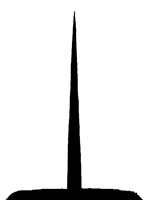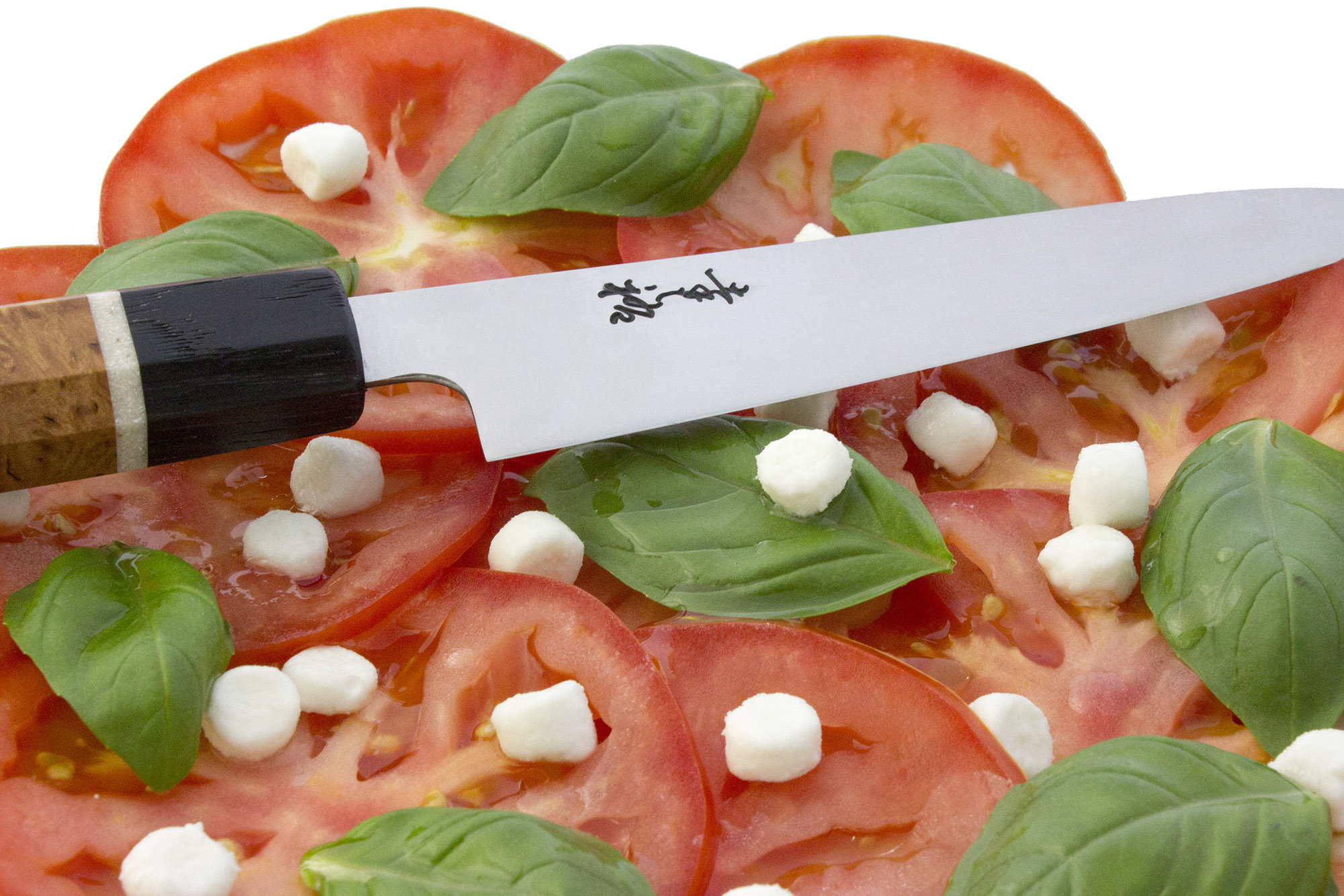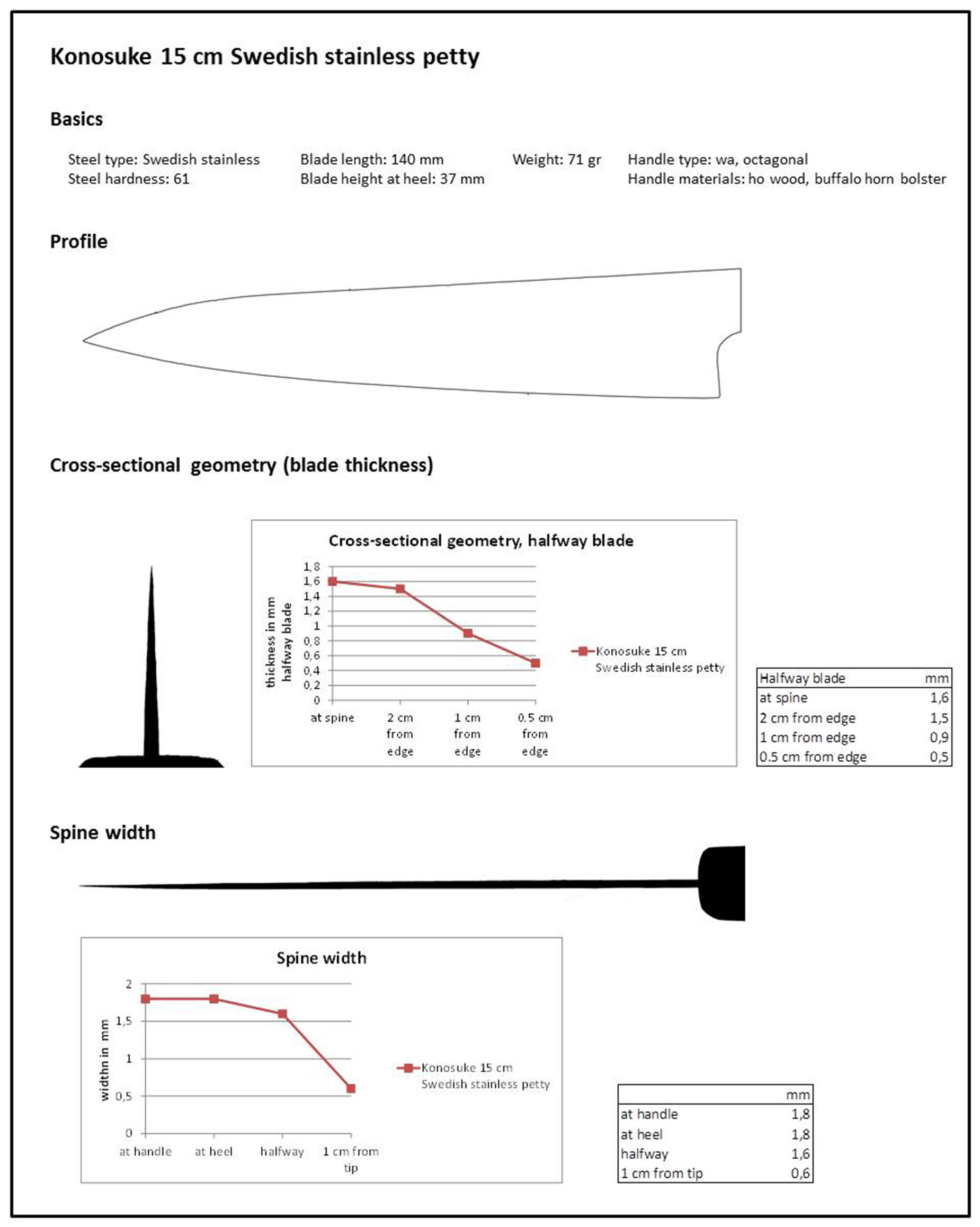Konosuke Swedish stainless petty
Recent › Forums › Main Forum › Off Topic › Konosuke Swedish stainless petty
- This topic has 8 replies, 5 voices, and was last updated 11/13/2015 at 6:18 am by
Mark76.
-
AuthorPosts
-
11/09/2015 at 5:24 pm #29384
It is said that in your kitchen you really need only two knives: a gyuto and a paring knife. I agree. Some people would throw in a bread knife, but that’s about it. For most home cooks the gyuto will be 21 to 24 centimeters and the paring knife will be 9 to 10 centimeters.
Nevertheless I found the gap between 9 cm and 21 cm rather large, so I thought there must be a use for a 15 cm knife, a petty. I got one, but I initially didn’t find much use for it. I still did nearly all the cutting with my gyuto and I grabbed my paring knife for paring and the occasional delicate work on a vegetable. I know quite a few chefs use an 18 cm or so petty as a line knife, but I am not a professional chef. Only now, a couple of years later, I find I instinctively grab my petty for a number of tasks.
So what do I use it for? Probably most for slicing sandwiches and buns. This is much cleaner than with a serrated knife and the petty has got the perfect length for it. I also use it as a small sujihiki. I usually make sushi and sashimi from small cuts of fish and a petty is perfect for that. The same goes for small cuts of meat. There are also some specialized tasks I use my petty for, like trimming silverskin. Or deboning a chicken, since I don’t have a boning knife. And because I’ve grown to like the knife, I sometimes use it to cut smaller vegetables, like tomatoes, as an alternative to a gyuto.
I recently got a 14 cm Konosuke Swedish stainless petty.
First impression
The fit and finish of this knife is very good. The blade is well polished: the grinding scratches are barely visible. Both the spine and the choil have been rounded. And the knife has a ho wood handle with a buffalo horn ferrule that fits the knife perfectly. Even though the handle is very ergonomic, I found it a bit bland. So I replaced it with a beautiful maple burl and bog oak handle by Anton Kudris.

One reason I got this knife is that it is very thin. The choil shot may not tell you that much, since it doesn’t tell the dimensions, but halfway the knife is 1.6 mm thick at the spine and it measures only 0.5 mm at half a centimeter from the edge. This makes it the thinnest knife in my house. The blade is slightly convexed on both sides.

The knife also has a very nice distal taper, from 1.8 cm above the heel to 0.6 cm one centimeter from the tip.

Use
Before use I sharpened the knife on my Shapton Pro stones, finishing at 16K. I then set out to slice some tomatoes. Who said a tomato needs a toothy edge?
I love the edge this steel can take! Even though Konosuke does not disclose the type of steel, I am almost certain it is 13C26 or its Uddeholm equivalent, AEB-L.

Due to its thinness the knife also performed wonderfully on onions. Well, the knife performed wonderfully on everything I threw at it. The knife has some flex, but surprisingly little, considering its thinness. I hardly notice it in practice. I sometimes make sashimi just to have an excuse to grab my Konosuke again.

Conclusion
I love this knife. Everything about it is perfect. That is not to say this knife is without competition. I already reviewed laser-type stainless knives by Suisin and Ashi Hamono, and they did a great job as well. But this Konosuke is going to stay in my house
Factsheet
Click on the factsheet to view a larger version.

Molecule Polishing: my blog about sharpening with the Wicked Edge
11/09/2015 at 7:08 pm #29385That’s an awesome review Mark!
-Clay
11/09/2015 at 8:50 pm #29386No doubt!! Great job mark and love all the pics =)
11/09/2015 at 9:12 pm #29388Great review, thanks.
How does the edge hold up to chopping on a board?
I like a knife this size for breaking down chickens, the small ones in Europe are too small for a large knife, but a pairing knife is not long enough. it is also good for sandwiches like you said.
11/09/2015 at 9:53 pm #29391Thanks, guiys. I think edge retention is pretty good, but I haven’t used it long enough to judge this properly. What I really like is is its ability to take an edge, I think it is on par of white #2.
Molecule Polishing: my blog about sharpening with the Wicked Edge
11/11/2015 at 11:31 pm #29425Ok Mark, you got me hooked now. What is the background on this brand? I don’t know anything about it. Why is it named “Swedish” if it is a Japanese knife? (I assume it is Japanese?). Why did you choose this one over other Japanese brands?
11/12/2015 at 9:57 am #29431Konosuke is one of the better Japanese kitchen knife brands. They make great users, like this knife, but also very special looking ones. They sometimes employ very highly skilled local knife makers to make small series for them. I was able to view most of these knives myself: http://www.japansemessen.nl/c-2171682/konosuke/ . I love the ones with damascus and a flower pattern on them…
Konosuke like to keep their steel composition secret, but from a reliable source I’ve got that it’s Sandvik steel. I suspect 13C26, because I can get it so sharp. But it could also be 19C27, which has a bit coarser carbides.
Molecule Polishing: my blog about sharpening with the Wicked Edge
11/12/2015 at 12:51 pm #29433I’ve been playing with very thin edges and am always amazed by how easily they cut.
Recently I did a couple of chef’s knives for my sister, moving the apex toward her opposite hand. This worked so good that right now, I’ve been modifying a Chicago Cutlery 6.5″ cleaver to a chisel type edge. After resetting the apex on the one side with my belt sander and a 2-degree jig block and using the Gen 2 vise, the very high edge limited me to about 28 degrees on the off side. It is astounding how thin you can slice something with this critter!! Turn the blade around and the bevel will immediately force the edge off of the material being cut.
Mark: With the single thin bevel shown in your diagram, I deduce that you are sharpening on a flat stone and not on the WEPS. What happens if you get a ding in the blade from say, hitting a bone? Surely you can’t stay with the same flat stone technique? Or can you? I’m curious because I’m afraid I may be going down a dangerous path with the acute included angles I’m producing.
An open question: When sharpening a chisel edge on a kitchen knife in the WEPS, how do you guys deal with the huge burr you get from stoning on one side only.
11/13/2015 at 6:18 am #29440Tom, the knife is a double bevel one. It’s probably rather difficult to see, because it is so thin.
If I do a single bevel knife on the WEPS, I usually I remove the burr on the other side by moving the knife nearly flat over a stone in a single pass or at most a few passes.
I usually sharpen a wide bevel knife (similar to a chisel edge) manually. It has a built-in angle guide, so that’s easy 🙂 .
Molecule Polishing: my blog about sharpening with the Wicked Edge
-
AuthorPosts
- You must be logged in to reply to this topic.